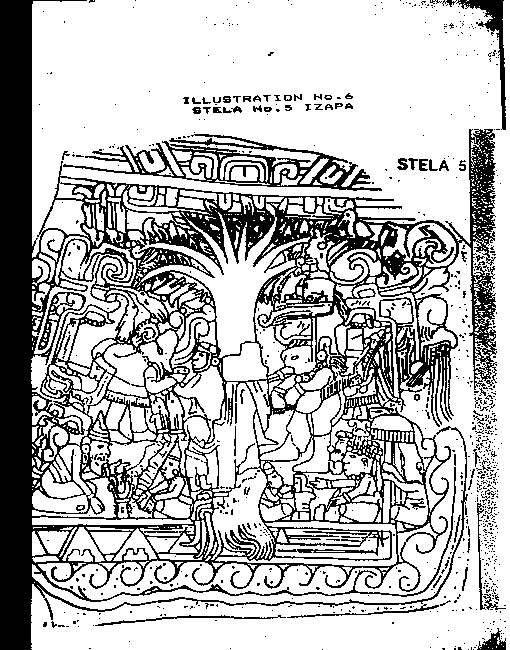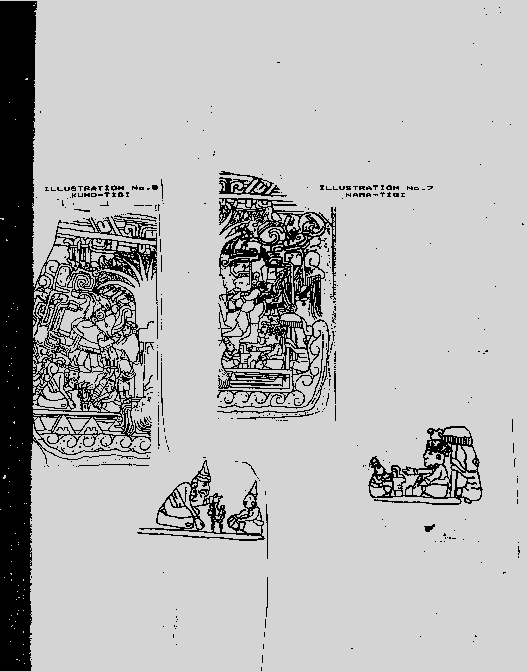Evidence
of the African Migration to America
By
![]()
![]()
By
![]()
INTRODUCTION The Stelae
no.5 from Izapa, is an important historical document
from
The research of the New World Archaeological Foundation
indicate that this site has been continously
occupied since 1500 B.C. Much of what we know about the art from Izapa comes from the work of Virginia Smith' Izapa Relief Carving (1984), Garth Norman's Izapa Sculpture (1976) and Jacinto Quirarte's
Izapan-Style Art (1973). V. Garth
The Stelae no.5 from Izapa records many glyphic elements common to other preclassic artifacts including the jaguar, falling water, mountain, bird, dragon tree, serpent and fish motifs.(Smith 1984:28-29) This stelae also provides many elements that relate to Mexican and Maya traditions as accurately analyzed by Norman (1976:165-236). Some ideological factors not fully discussed in regards to this stelae is its discussion of elements of the Olmec religion, and the migration traditions of the Mexicans.
ANCIENT MIGRATION STORIES OF MEXICO The Maya were
not the first to occupy the
M. Swadesh (1953) has presented evidence that at least 3200 years ago a non- Maya speaking group wedged itself between the Huastecs and the Maya. Soustelle (1984: 29) tells us that "We cannot help but think that the people that shattered the unity of the Proto-Mayas was also the people that brought Olmec civilization to the region".
Traditions mentioned by Sahagun, record the
settlement of
This new race may have come from
Friar Diego de Landa (1978:8,28) , in Yucatan
Before and After the Conquest, wrote that "some old men of Yucatan say
that they have heard from their ancestors that this country was peopled by a
certain race who came from the East, whom God delivered by opening for them
twelve roads through the sea". This tradition is most interesting because
it probably refers to the twelve migrations of the Olmec
people. This view is supported by the stone reliefs
from

It is clear that Stela No.5, from Izapa not only indicates the tree of life, it also confirms
the tradition recorded by Friar Diego de Landa that
the Olmec people made twelve migrations to the New
World. This stela also confirms the tradition
recorded by the famous Mayan historian Ixtlixochitl,
that the Olmec came to
In the center of the boat on Stela No.5, we find a large tree. This tree has seven branches and twelve roots. The seven branches probably represent the seven major clans of the Olmec people. The twelve roots of the tree extending into the water from the boat probably signifies the "twelve roads through the sea", mentioned by Friar Diego Landa.
The migration traditions and Stela No.5, probably
relates to a segment of the Olmec, who landed in
boats in Panotha or Pantla
(the Huasteca) and moved along the coast as far as
THE STELAE NUMBER 5 AND OLMEC RELIGION
The Olmec people had their own writing. This writing system was deciphered by Winters(1977,1979; Wuthenau 1980) This decipherment of the Olmec writing allows us to discover much about the Olmec people and their culture.
The Olmecs had two different religious
associations (gya-fa):the
jaguar-man or humano-feline cult and the humano-bird cult. The humano-feline
cult was called the nama-tigi (see Illustration No.7
below) by the Olmecs, while the humano-feline
cult was called the kuno-tigi(see Illustration No.6 below). The leadear
of the Olmec cult was called the tigi
or amatigi "head of the faith". The tigi of the Olmec secret
societies or cults exerted considerable influence both dead and alive. Alive he
could contact the spirits of the deceased, and serve as intermediaries between
the gods and mankind. Upon his death his grave became a talisman bestowing good
to all who visited his tomb.
Dr. Sertima (1976) and Wiener (1922) have both
commented on the possible relationship between the amanteca
of ancient
Many Meso-Americanists have suggested that the Maya inherited many aspects of their civilization from thew Olmec.(Soustelle 1984) This is interesting because in the Maya Book of Chumayel, the three main cult associations which are suppose to have existed in ancient times were (1) the stone (cutters) cult, (2) the jaguar cult and (3) the bird cult. In lines 4-6 of the Book of Chumayel , we read that "Those with their sign in the bird, those with their sign in the stone, flat worked stone, those with their sign in the Jaguar-three emblems-".(Brotherston 1979) The Book of Chumayel, corresponds to the gylphs depicted on Monument 13 at La Venta

. On Monument 13, at La Venta a personage in profile, he has a headress on his head and wears a breechcloth, jewels and sandals, along with four glyphs listed one above the other. The glyphs included the stone, the jaguar, and the bird emblems. Monument 13, at La Venta also has a fourth sign to the left of the personage a foot gylphs. This monument has been described as an altar or a low column.
The foot in Olmec is called "se", this symbols means to "lead or advance toward knowledge, or success". The "se" (foot) sign of the komow (cults) represent the beginning of the Olmec initiates pursuit of knowledge.
The meaning of Monument 13, reading from top to bottom,
are a circle kulu/ kaba
(the stone), nama (jaguar) and the kuno (bird). The interpretation of this column reading from
left to right is "The advance toward success--power--for the initiate is
obedience to the stone cutters cult, jaguar cult and the bird cult". The
Jaguar mask association dominated the
In the central and southern Olmec regions we find
the bird mask association predominate as typified by
the Xoc bas relief of
The iconographic representation of the Olmec priest-kings, found at Chalchapa, La Venta, Xoc and Chalcatzing indicate that usually the Olmec priest wore a wide belt and girdle. He was usually clean shaven, with an elogated bold head often topped by a round helmet or elaborate composite mask. During religious ceremonies the Olmec religious leader, depending on his cult would wear the sacre jaguar or sacre bird mask. Often as illustrated by the glyphs on the shoulders and knees of the babe-in-arms figurine of Las Limas element the mask would include a combination of the associated with the bird, jaguar and serpent.
The cult leaders of the bird mask cult usually wore claws on their feet. The jaguar cult leaders usually wore the jaguar mask.
Stelae No.5 also discusses in detail the two major Olmec religions: the nama (jaguar) komo (cult) and the kuno (bird) komo. At the top of Stela No.5 , we recognize two lines of Olmec writing across the top of the artifact. On the first line we read from right to left :I ba i. Lu tu lu. I ba i, which means "Thou art powerful Now! Hold Upright (those) obedient to the[ir] Order. Thou art Powerful Now!" On the second line we read the following I lu be. I lu , which means "Thou hold upright Unity. Thou [it] upright" (see Table of Olmec signs 1,and 2 ).
The religious orders spoken of in this stela are the Bird and Jaguar cults. These Olmec cults were Nama or the Humano-Jaguar cult; and Kuno or Bird cult. The leader of the Nama cult was called the Nama-tigi (see Nama chief Illustration 7 Stela No.5 Izapa) , or Amatigi (head of the faith). The leader of the Kuno cult was the Kuno-tigi (Kuno chief see Illustration 6 Stela No.5). These cult leaders initiated the Olmec into the mysteries of the cult.
On the Stela No. 5, we see both the Kuno-tigi and Nama-tigi instruction youth in the mysteries of their respective cults. On Stela No.5, we see two priests and members of each cult society sitting in a boat with a tree in the center.(Wuthenau 1980;Sitchin 1990,p.178) On the righthand side of the boat we see the Nama-tigi, and on the left hand side we see the Kuno-tigi.
Illustrations of the Nama-Tigi (No.7)and Kuno-Tigi(No.6)

The personage on the right side of the boat under a ceremonial umbrella is
the Nama-tigi (see Illustration No.7). In
On the sides of the boat we see two Olmec signs they read: "In the company of Purity". This statement signifies that the Olmec believed that worship of the Kuno or Nama cults led to spiritual purity among the believers.
Izapa Stela No.5

On the left hand side of the boat we see a number of birds. Here we also find a priest wearing a conical hat instructing another youth, in the mysteries of the Kuno cult around a flame.

Among the Olmecs this flame signified the luminous
character of knowledge. The Kuno priest wears a
conical hat(see Illustration No.6). The evidence of
the conical hat on the Kuno priest is important
evidence of the Manding in ancient
"That the kingly and priestly cap of the Magi should have been preserved in America in the iden -tical form, with the identical decoration,and should, besides, have kept the name current for it among the Mandingo [Malinke-Bambara/Manding] people , makes it impossible to admit any other solution than the one that the Mandingoes established the royal offices in Mexico".

Stelea no.21 ,from Izapa also record the decline of the Olmec nama and kuno religions and probable raise of the Maya speakers and the sa (serpent) cult which called forhuman sacrifice. On Stelae no.21, we see a decapitated individual lieing on the ground.
An elite carries the decapitaed head. This elite may be an early Maya personage because he wears a new style headdress which resembles the Maya style headdresses.
In the background we see an elite personage being borne in an elaborate sedan chair. Above this chair we see the serpent .
This depiction of a serpent as a background but dominate figure in Olmec religion/rule corresponds to Monument 19 of La Venta. On Monument 19, from La Venta we see an Olmec personage which has a serpent behind his back and above his head. This serpent indicates hidden knowledge or powers from the serpent that the cult leader used to lead the followers of their cult.
In conclusion , Stela
No.5 Izapa provides the story behind the African
migration to
![]()